Archaeologists have uncovered several ancient Egyptian tombs, including one that is believed to be more than 4,000 years old.
Researchers from a joint Egyptian-Japanese archaeological mission involving the Ministry of Tourism and Antiquities and Kanazawa University made the discoveries at the site of Saqqara, which is around 20 miles south of Cairo.
Saqqara is one of the largest and most important ancient Egyptian archaeological sites. It is home to a vast burial ground—which once served the ancient Egyptian capital of Memphis—where numerous nobles were laid to rest. The site also contains what is widely thought to be the oldest pyramid in the country.
Within the newly uncovered tombs at Saqqara, which date to various historical eras, the researchers documented a number of human remains and artifacts during their excavations.
The excavations took place from August to September 2023 on the eastern escarpment of the North Saqqara plateau. This area has not been the subject of excavations before.

The "most notable" discovery was a rock-cut tomb dating to ancient Egypt's Second Dynasty, Nozomu Kawai, head of the mission with Kanazawa University in Japan, told Newsweek. This dynasty ruled the territory in the first half of the third millennium B.C. during Egypt's Early Dynastic Period.
In the rock-cut tomb, the team found the remains of an individual in a crouched position inside a box-shaped coffin.
Other finds from the recent excavations include burials from the early Eighteenth Dynasty (around 1550-1292 B.C.), the Late Period (664-332 B.C.), the Ptolemaic period (332-30 B.C.) and the early Roman period (around the first-second centuries).
"It is very important to find the burials of the early Eighteenth Dynasty in Saqqara necropolis because we did not have much information about the tombs there at the beginning of [this period]," Kawai said.
The largest burial complex the team have found in North Saqqara is a Greco-Roman catacomb. The team originally discovered the catacomb in 2019, although the researchers were not able to investigate it after the discovery due to the condition of the bedrock ceiling and the long hiatus of the COVID-19 pandemic.
"Due to the insecure condition of the bedrock ceiling, we could not excavate there until the last season," Kawai said. "It seems this tomb has been sealed since the Roman period."
During the most recent excavations, the mission found more than 30 individual human remains in the Greco-Roman catacomb, including mummies. The team also documented two mummy funerary masks and several terracotta figurines, including some depicting the goddess Isis-Aphrodite. This deity is a form of the Egyptian goddess Isis combined with the fertility aspects associated with the Greco-Roman goddess Aphrodite.
Isis is one of the most important goddesses in ancient Egyptian mythology. Renowned for her magical powers, she was subsequently worshipped throughout the Greco-Roman world as well.
The latest discoveries provide "invaluable insights into the history of this region," Kawai said, according to Egyptian media outlet Ahram Online.
In a press release, Kawai said he hopes the mission will make more discoveries in the region during its upcoming excavation seasons that will reveal more of Saqqara's secrets.
"I believe many important tombs are still hidden under the sand," Kawai said.
Update 1/12/24, 8:52 a.m. ET: This article has been updated with comments from Nozomu Kawai.
Uncommon Knowledge
Newsweek is committed to challenging conventional wisdom and finding connections in the search for common ground.
Newsweek is committed to challenging conventional wisdom and finding connections in the search for common ground.
About the writer
Aristos is a Newsweek science reporter with the London, U.K., bureau. He reports on science and health topics, including; animal, ... Read more
To read how Newsweek uses AI as a newsroom tool, Click here.








